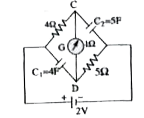The cell potential (Ecell) of a reaction is related as △G=−nFEcell, where △Grepresents max. useful electrical work
n=no. of moles of electrons exchanged during the section
for reversible cell reaction d(△G)=(△rV)dp−(△rS),dT
at constant pressure d(△G)=−(△rS).dT
:' At constant pressure △G=△H−T.△S
:. △G=H+Td(△G)(dT)P
(dEcelldT)P is known as temperture coefficient of the e.m.f of the cell.
The temperature coefficient of the e.m.f of cell, (dEdT)P si given by:
nF△S
△SnF
△SnFT
#REF!
The correct Answer is:B
To find the temperature coefficient of the e.m.f. of the cell, we start with the relationship between the Gibbs free energy change (ΔG) and the cell potential (E_cell). The equation is given by:
ΔG=−nFEcell
where:
- ΔG is the Gibbs free energy change,
- n is the number of moles of electrons exchanged,
- F is Faraday's constant,
- E_cell is the cell potential.
Step 1: Differentiate ΔG with respect to temperature
At constant pressure, we know that:
dΔG=−ΔSdT
where ΔS is the entropy change. This means that:
dΔGdT=−ΔS
Step 2: Differentiate E_cell with respect to temperature
From the relationship between ΔG and E_cell, we can differentiate E_cell:
dEcell=−dΔGnF
Substituting the expression for dΔG from Step 1 into this equation gives:
dEcell=−(−ΔSdT)1nF=ΔSnFdT
Step 3: Find the temperature coefficient
Now, we can find the temperature coefficient of the e.m.f. of the cell, which is defined as:
(dEcelldT)P=ΔSnF
Conclusion
Thus, the temperature coefficient of the e.m.f. of the cell is given by:
(dEcelldT)P=ΔSnF
Final Answer
The temperature coefficient of the e.m.f. of the cell is ΔSnF.
---
- ΔG is the Gibbs free energy change,
- n is the number of moles of electrons exchanged,
- F is Faraday's constant,
- E_cell is the cell potential.
At constant pressure, we know that:
From the relationship between ΔG and E_cell, we can differentiate E_cell:
Now, we can find the temperature coefficient of the e.m.f. of the cell, which is defined as:
Thus, the temperature coefficient of the e.m.f. of the cell is given by:
The temperature coefficient of the e.m.f. of the cell is ΔSnF.
Topper's Solved these Questions
- BOOK - NARENDRA AWASTHI ENGLISHCHAPTER - ELECTROCHEMISTRYEXERCISE - Match the column6videos
ELECTROCHEMISTRY
- BOOK - NARENDRA AWASTHI ENGLISHCHAPTER - ELECTROCHEMISTRYEXERCISE - Assertion Reason type question15videos
ELECTROCHEMISTRY
- BOOK - NARENDRA AWASTHI ENGLISHCHAPTER - ELECTROCHEMISTRYEXERCISE - LEVEL-228videos
ELECTROCHEMISTRY
- BOOK - NARENDRA AWASTHI ENGLISHCHAPTER - DILUTE SOLUTIONEXERCISE - leval-0323videos
DILUTE SOLUTION
- BOOK - NARENDRA AWASTHI ENGLISHCHAPTER - GASEOUS STATEEXERCISE - Subjective problems15videos
GASEOUS STATE
Similar Questions
ΔG=ΔH−TΔS and ΔG=ΔH+T[d(ΔG)dT]p, then(dEcelldT) is
View SolutionΔG=ΔH−TΔS and ltBRgt ΔG=ΔH+T[d(ΔG)dT]p, then(dEcelldT) is
View SolutionDerive an expression relating standard e.m.f. of the cell with the equilibrium constant of the cell reaction.
View SolutionFor a spontaneous reaction ΔG∘ and E∘ cell will be respectively :
View SolutionFor a spontaneous reaction ΔG∘ and E∘ cell will be respectively :
View SolutionWhen a flaccid cell (e.g., grape raisin ) is placed in water
View SolutionUnder what condition is E∘cell=0 or ΔrG=0?
View SolutionIn the circuit shown in Fig., the cell is ideal with e.m.f = 2V. The resistance of the coil of the galvanometer G is 1Ω. Then
 View Solution
View SolutionCan E∘cell or ΔrG∘ for cell reaction ever be equal to zero?
View SolutionWrite the cell reaction for each of the following cells.
Pt,H2(g)∣∣H+(aq)∣∣Ag+(aq)∣Ag(s)View Solution

